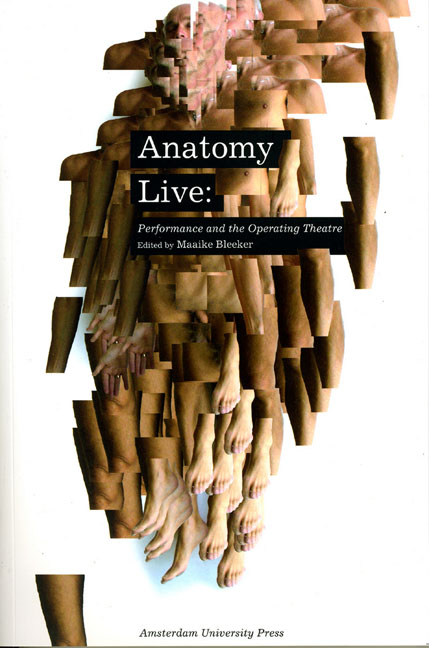Book contents
- Frontmatter
- Contents
- Acknowledgements
- Prologue - Men with Glass Bodies
- Introduction
- Performance Documentation 1: Holoman; Digital Cadaver
- Digital Cadavers and Virtual Dissection
- ‘Who Were You?’: The Visible and the Visceral
- Performance Documentation 2: Excavations: Fresh but Rotten
- The Anatomy Lesson of Professor Moxham
- ‘Be not Faithless But Believing’: Illusion and Doubt in the Anatomy Theatre
- Performance Documentation 3: De Anatomische Les
- Of Dissection and Technologies of Culture in Actor Training Programs – an Example from 1960s West Germany
- Ocular Anatomy, Chiasm, and Theatre Architecture as a Material Phenomenology in Early Modern Europe
- Performance Documentation 4: Camillo – Memo 4.0: The Cabinet of Memories – A Tear Donnor Session
- Martin, Massumi, and the Matrix
- Performance Documentation 5: Sensing Presence no 1: Performing a Hyperlink System
- ‘Where Are You Now?’: Locating the Body in Contemporary Performance
- Performance Documentation 6: Under My Skin
- Anatomies of Live Art
- Performance Documentation 7: Crash
- Restaging the Monstrous
- Delirium of the Flesh: ‘All the Dead Voices’ in the Space of the Now
- Performance Documentation 8: Körper
- Operating Theatres: Body-bits and a Post-apartheid Aesthetics
- Index
The Anatomy Lesson of Professor Moxham
Published online by Cambridge University Press: 10 February 2021
- Frontmatter
- Contents
- Acknowledgements
- Prologue - Men with Glass Bodies
- Introduction
- Performance Documentation 1: Holoman; Digital Cadaver
- Digital Cadavers and Virtual Dissection
- ‘Who Were You?’: The Visible and the Visceral
- Performance Documentation 2: Excavations: Fresh but Rotten
- The Anatomy Lesson of Professor Moxham
- ‘Be not Faithless But Believing’: Illusion and Doubt in the Anatomy Theatre
- Performance Documentation 3: De Anatomische Les
- Of Dissection and Technologies of Culture in Actor Training Programs – an Example from 1960s West Germany
- Ocular Anatomy, Chiasm, and Theatre Architecture as a Material Phenomenology in Early Modern Europe
- Performance Documentation 4: Camillo – Memo 4.0: The Cabinet of Memories – A Tear Donnor Session
- Martin, Massumi, and the Matrix
- Performance Documentation 5: Sensing Presence no 1: Performing a Hyperlink System
- ‘Where Are You Now?’: Locating the Body in Contemporary Performance
- Performance Documentation 6: Under My Skin
- Anatomies of Live Art
- Performance Documentation 7: Crash
- Restaging the Monstrous
- Delirium of the Flesh: ‘All the Dead Voices’ in the Space of the Now
- Performance Documentation 8: Körper
- Operating Theatres: Body-bits and a Post-apartheid Aesthetics
- Index
Summary
If you were to enter a theatre of anatomy, what would you expect to see? A musty old museum perhaps, replete with pickled specimens, deformed skeletons, and faded anatomical atlases? Or you may be anticipating a tour of the architectural splendours of the Vesalian Teatro Anatomico in Padua, where executed criminals had their bodies publicly dissected by the master anatomist for the edification of a paying audience of the great and the good. Perhaps, you expect to glimpse these bodies, their skin pinned back by alphabetical markers like so much loose cloth on a lifeless mannequin? Or are you of the opinion that these spectacles and specimens should remain off-limits to all but staff and students of the medical schools? But what if I were to tell you that from the comfort of your own home, you too may become a spectator in the theatre of the dead, and that the digital body of an executed criminal may be downloaded onto your computer at the flick of a switch, just as his real body was extinguished when the executioner threw the switch on his ‘electric chair’.
Or perhaps you were under the impression that it was only metaphysical mavericks like Rene Descartes that searched for the soul in the seat of the brain, labouring under the illusion that the ‘mind's eye’ could, in a fashion, perceive images and sense pain and pleasure through the flow of ‘pineal spirits’ as he suggested in his complex and ultimately flawed La Dioptrique of 1637. Descartes's probing fingers were simply too blunt an instrument with which to decode that most complex of organs, the brain, but had he had access to a twenty-first-century fMRI scanner, he would indeed have proved his point that it is possible to ‘read’ the mind and to render (digitally) what pain and pleasure look like. It may also surprise you to learn that you may not be so very different from that Vesalian spectator peering over vertiginous Renaissance balconies gawping at the subject made object, only your viewing is restricted to the television screen or computer monitor, or perhaps as a ‘ringside’ spectator at one of the infamous Gunther von Hagens 's ‘live’ autopsies.
- Type
- Chapter
- Information
- Anatomy LivePerformance and the Operating Theatre, pp. 75 - 92Publisher: Amsterdam University PressPrint publication year: 2008



